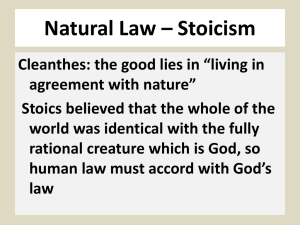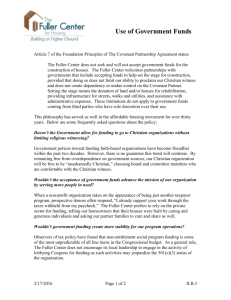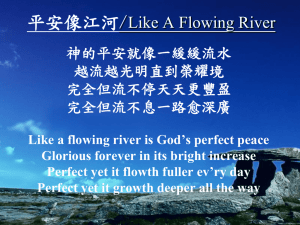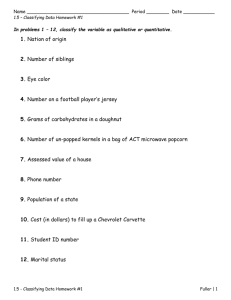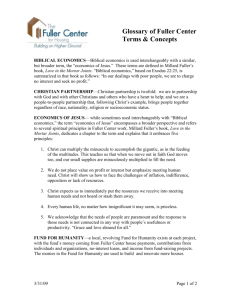fuller`s earth resources of rajasthan
advertisement
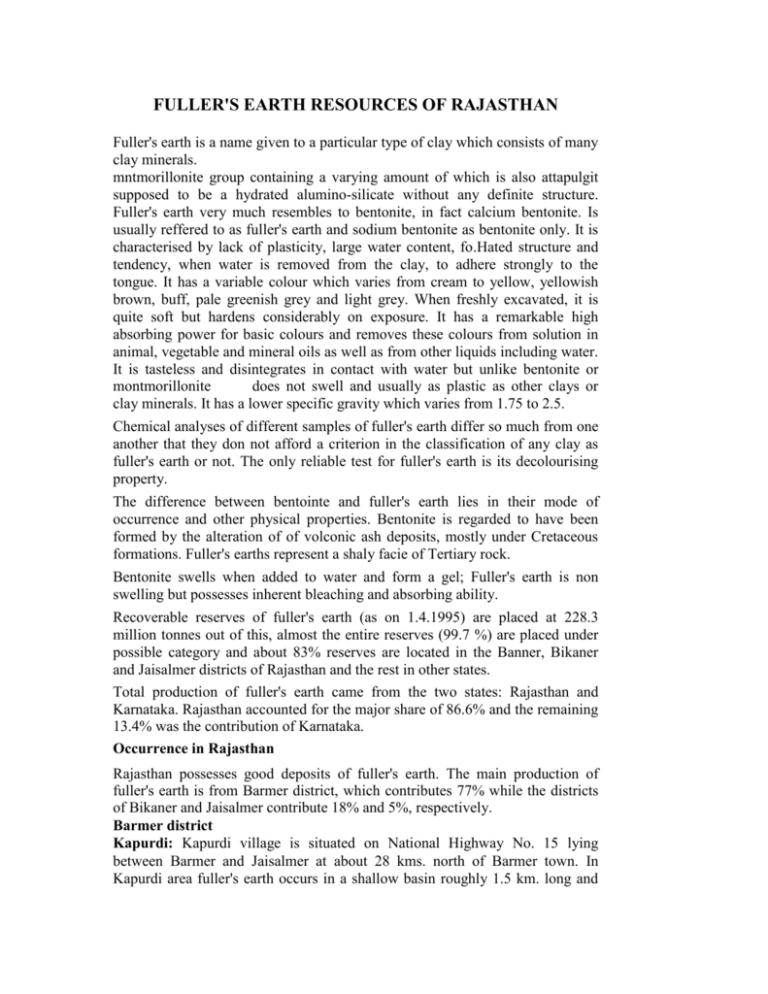
FULLER'S EARTH RESOURCES OF RAJASTHAN Fuller's earth is a name given to a particular type of clay which consists of many clay minerals. mntmorillonite group containing a varying amount of which is also attapulgit supposed to be a hydrated alumino-silicate without any definite structure. Fuller's earth very much resembles to bentonite, in fact calcium bentonite. Is usually reffered to as fuller's earth and sodium bentonite as bentonite only. It is characterised by lack of plasticity, large water content, fo.Hated structure and tendency, when water is removed from the clay, to adhere strongly to the tongue. It has a variable colour which varies from cream to yellow, yellowish brown, buff, pale greenish grey and light grey. When freshly excavated, it is quite soft but hardens considerably on exposure. It has a remarkable high absorbing power for basic colours and removes these colours from solution in animal, vegetable and mineral oils as well as from other liquids including water. It is tasteless and disintegrates in contact with water but unlike bentonite or montmorillonite does not swell and usually as plastic as other clays or clay minerals. It has a lower specific gravity which varies from 1.75 to 2.5. Chemical analyses of different samples of fuller's earth differ so much from one another that they don not afford a criterion in the classification of any clay as fuller's earth or not. The only reliable test for fuller's earth is its decolourising property. The difference between bentointe and fuller's earth lies in their mode of occurrence and other physical properties. Bentonite is regarded to have been formed by the alteration of of volconic ash deposits, mostly under Cretaceous formations. Fuller's earths represent a shaly facie of Tertiary rock. Bentonite swells when added to water and form a gel; Fuller's earth is non swelling but possesses inherent bleaching and absorbing ability. Recoverable reserves of fuller's earth (as on 1.4.1995) are placed at 228.3 million tonnes out of this, almost the entire reserves (99.7 %) are placed under possible category and about 83% reserves are located in the Banner, Bikaner and Jaisalmer districts of Rajasthan and the rest in other states. Total production of fuller's earth came from the two states: Rajasthan and Karnataka. Rajasthan accounted for the major share of 86.6% and the remaining 13.4% was the contribution of Karnataka. Occurrence in Rajasthan Rajasthan possesses good deposits of fuller's earth. The main production of fuller's earth is from Barmer district, which contributes 77% while the districts of Bikaner and Jaisalmer contribute 18% and 5%, respectively. Barmer district Kapurdi: Kapurdi village is situated on National Highway No. 15 lying between Barmer and Jaisalmer at about 28 kms. north of Barmer town. In Kapurdi area fuller's earth occurs in a shallow basin roughly 1.5 km. long and 250 m. wide with an approximate north-south axis. The maximum thickness (50 m.) of the fuller's earth is found near the centre of the basin and the beds thin out towards the southen and northern boundaries of thti basin. The fuller's earth is well bedded, nonarenacens, creamy yellow or yellowish brown in colour and occurs at 2 to 5 m. below surface. Imperfectly preserved cast of some molluscs and echinoids are found in the fuller's earth and in the ironstone bands occurring intercalated in it. . Based on exploratory borehole data, collected during investingation for lignite, the inferred reserves of fuller's earth in an area of 6.37 sq. km. are of the order of 78 million tonnes assuming specific gravity 2.00. Acid activation tests of fuller's earth from this area conducted at R.R.L., Hydrabad have indicated that fuller's earth could be-activated acid treatment and the product obtained was comparable to imported bleaching earths. Similar tests on the fuller's earth samples have been conducted by departmental ceramic laboratory and the results show that the sample having above 1.0% exchangeable calcium oxide has given best results when activated with 25% sulphur acid followed by thermal activation at 350°C. Bharka: Bharka is located about 22 km. from Barmer district on National Highway 15 connecting Barmer and Jaisalmer districts. At Bharka village, a 3 m. thick fuller's earth occurs bed is found to occur at about 15 m. depths. Rohli: Another deposit of fuller's earth occurs at a distance of 1.5 km. east of Rohli village. The material appears to be of good quality and it can be excavated in large lumps. Alamseria-kurla: The deposit is situated about 6 km. distance from Barmer on Barmer-Balotra road. The fuller's earth bed in the area is. over 8 m. in thickness and is overlain by a 2-3 m. thick sub Recent calcareous conglomerate with pebbles and boulders of volcanic rocks. The deposit is fairly large covering about 1 sq. km. area. Sheo: Fuller's earth is exposed for about 120 m. in nala cutting, about seyen furlongs east of Sheo, where the land is mostly covered by some calcareous material and pebbles of quartz. Here fuller's earth is light yellowish in colour flaky and in appearance resembles the fuller's earth from Kapurdi area. The bed of fuller's earth in this area is more or less horizontal; as such it can be safely be taken to extend for about 80 m. on each side of the nala. The tentative reserve available in this area is of the order of 100,000 tonnes. The occurrence of fuller's earth is also observed near Joranda, Lalu Kothri, Jilala and Hemnada. Bikaner district Fuller's earth deposits of Palana are situated about 23 km. SW of Bikaner city. In this area the fuller's earth occurs in the Palana shals over laying the lignite seam. It has a thickness of 1.8 to 2.4 m. and occurs at about 50 m. depths from the ground level. It stretches over the entire Palana coal field and is roughly 5 km. in length and about 750 m. in width. It is silvery white, translucent, possesses good lusture, siliceous in parts and slightly colored yellowish. In past it was mined through a number of shafts sunk exclusively for this. These were. known as the "Multani Mitti Shafts" and had yielded some production for a few years but later due to the difference in quality and also high cost of production, those were closed. The estimated reserves are of theorder of 85 million tonnes. Kolayat: Kolayat is located at 51 kms. SW of Bikaner. In this area, the in two horizons,. namely upper and lower. Only the upper horizon formthe main deposit and is of "economic value. Upper Horizon: The fuller's earth of this horizon is located between Marh and Jogira Talab, about 7 kms.North of Marh, and is exposed along the escarpment of the cuesta. The best exposures occur at 1 km. south and 500 m. south east of Jogira Talab where its thickness is 11 m. and 7 m., respectively. The fuller's earth of this horizon is grey to greyish yellow and reddish, soft, well bedded foliated with shale and shaly limestone partings. The thickness of the recent formation on the top of the cuesta is 3 to 10 m. increasing towards Jogira Talab. The probable reserves of high grade and low grade fuller's earth are 4.33 and 2.77 MT, respectively. Besides this, the inferred reserves are 12 million tonnes. . Indo-Ka-Bala: The area is situated about 400 m. north of village Indo-Ka-Bala and about 1.6 km. west of village Chandi. The fuller's earth bearing area proved as a result of prospecting by state department extends to about 14, 00,000 sq. feet. As a result of prospecting it appears that the average thickness of the workable bed of fuller's earth varies .between 8 to 10 feet, with an average over burden between 5 to 6 feet. The total reserve of the workable quality of fuller's earth comes to 3.5 lacs tonnes. An occurrence of fuller's earth near Kesardesar is also. reported by Department of Mines and Geology during exploratory drilling for lignite. Nagaur district In Nagaur district Kuchera-Khajwana Formation (Eocene age) is reported to contain fuller's earth associated with ferruginous gritty felspathic sandstone, black shale and lignite. An occurrence of fuller's earth about 10 m. thick in a well section, 1.5 km. north of Igiar was located by G.S.I. It appears to occur as small pocket and lenses and is generally mixed with angular quartz grains. Good quality fuller's earth is exposed in well section of Arisar, Deswal and Chhapri. Jaisalmer district In Jaisalmer district fuller's earth occurs at Mandha and Khuiala, associated with Khuiala limestone. Near Mandha it is 0.60 to 2.75 m. thickness and a reserve of 80 thousand tonnes has been estimated. Near Khimsar, Pangli, Khuiala and Bandah, it occurs as 0.5 m. to 1.5 m. thick band associated with Eocene limestone. Near Dhalo-Ki-Dungri, a 3 m. thick fuller's earth bed is reported to occur. Minor occurrences are reported in sam and Ramgarh areas. Uses Fuller's earth was originally used as fulling or cleaning the grease and stains from wool and cloth. It is used for bleaching (decolourizing) cotton, wool and oil. Usually it is used to clean lard oil but is also used for castor, linseed, coconut and other oils as well as tallow and greases. Mineral oils are also cleaned by fuller's earth. It has also been used as a carrier for colours in cheap pigments used in wall paper printing. It possesses good absorbing ability and requirements for this purpose are : (a) it must bleach well (b) it must not cause the oil to revert to its original colour (c) it must be of open texture pocket and lenses a quartz grains. Good quality fuller's earth is nd is generally so that it must filter well (d) It must not absorb more oil. (e) It must not catch fire when removed from thefilterpress. (f) It must not give any permanent taste or colour to the oil. Extended use of fuller's earth is in refining and bleaching of glyceride oils; clarification and purification of sugar cane juce, syrup and wines; water purification; sewerage and effluent treatment absorbent for oil spillage and factory floors, pet and' animal litter; as a carrier for insecticides and fungicides : and as mineral filler and extender. Specification The specification for fuller's earth depends hugely on the nature of the work to be done. For refining vegetable, animal and mineral oils by the contacting method, finely pulverized clay is used, having a mesh of at least 50 pct through 200 and generally from 85 to 95 pct through 200. The limiting factors on finess are filter rate, or the speed with which the oil can be separated from the clay cake after contacting and oil retention. When the percolation method is used, a coarse mesh is required in order to permit free passage of the oil through the clay. The most popular percolation grade is that known as 30/60 mesh. Other standard-mesh percolation grades are 60/90 and 15/30. District wise No. of Leases, Production Sale- Value and Revenue of Fuller's Earth in Rajasthan (Year 2000-2001) District No. of leases Production Sale value (000'T) (Lacs Rs.) Revenue (000'Rs) Barmer 15 13.140 13.74 1 0.000 0.000 5 1.808 0.27 1 0.259 0.05 22 15.807 14.06 365.29 Bikaner 50.00 Bundi 18.08 Bhilwara 5.91 Total 439.28 Statistical Information of Fuller's Earth in Rajasthan (Year 1997-2002) Year Production Revenue No. (000'T) (000'Rs.) 1997-1998 21.940 1003.89 26 1998-1999 17.843 1090.13 23 1999-2000 15.230 762.07 24 2000-2001 17.000 389.15 19 2001-2002 15.807 439.28 22 of Leases

